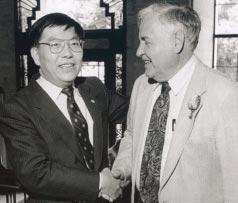
3 minute read
The College of Natural Resources Reaches 30 Years
Hilgard also began in-the-field meetings called Farmerís Institutes to bring newfindings and new ideas directlyto the farmers. This idea continues todayas the Universityof California Cooperative Extension.
Farming,Forestry,and Agricultural Economics
Advertisement
Although farmers accepted the benefits of bringing science to agriculture, theywanted a universityto offer practical training under actual farming conditionsó not possible on a large scale at the urban Berkeleycampus. In 1909, the UniversityFarm was established in Davisville (later renamed Davis) as a field station for Berkeleyagricultural research.
Forestryheld a place in research and education dating back to Hilgardís arrival on campus. In 1914, a formal Division of Forestrywas established within the College of Agriculture. The forestryprogram has evolved during the last 90 years, and still represents one of the most important areas of research and education within CNR (see Forestryand Rangeland Science).
In 1913, the Division of Rural Institutions was established, becoming the Division of Agricultural Economics by1926. A generous donation of $1.5 million dollars byAmadeo Peter Giannini, founder of the Bank of America, funded the creation of the Giannini Foundation and the building of Giannini Hall (see Agricultural Economics).
By1946, several Universityof California campuses had been established and a systemwide reorganization of agricultural programs ensued. The Division of Agricultural Sciences was created to oversee related programs at Berkeley, Davis, Los Angeles, and Riverside. As part of this restructuring, the forestry program was separated from the College of Agriculture to become a professional school. In 1959, the Regents declared that Davis was to be a general campus of the University. Several programs originallylocated at Berkeleytook up permanent residence at Davis.
Today, the Division of Agricultural and Natural Resources still provides overarching programmatic support for the three remaining land-grant programs at Berkeley, Davis, and Riverside, including the Agricultural Experiment Station researchers, campus-based Cooperative Extension specialists, and county-based Cooperative Extension advisors. Chancellors and deans on each campus retain authorityover facultyhiring and evaluation, and over academic programs.
The Birth of CNR
In the late 1960s and early1970s, societal views of agriculture, forestry, and the environment began to change. Agricultural production and environmental quality were examined with a newunderstanding of the impact of human actions on the natural world. Agricultureís political position in the University changed as well: the Chair of the State Board of Agriculture lost his position as an ex-officio member of the Board of Regents.
Earlier that era, in 1961, the College of Agricultural Sciences developed a newacademic plan emphasizing the basic sciences and strengthening graduate programs in entomology, genetics, molecular biology, and nutrition. Meanwhile, the School of Forestry expanded to include broader environmental and social research and in 1968 was renamed the School of Forestryand Conservation.
The College of Agricultural Sciences and School of Forestryand Conservation were separate, but theyshared programmatic strengths and a great degree of facultyand student interaction. The College offered lower-division courses in soils, genetics, entomology, pathology, and resource economics, which supported upper division programs in both academic units. Both units contained internationallyrecognized graduate programs. Theyeven shared a verypopular joint major, Conservation of Natural Resources, a program that was initiallyproposed byRichard Doutt, acting dean of the College of Agriculture, and developed bya group of facultyfrom both units.
Yet several factors were pointing towards a need to consider organizational change. While interest in forest and resource management and enrollment at the School of Forestryand Conservation were high, the Collegeís undergraduate enrollments were declining. Students planning to pursue a career in production agriculture typically attended Davis rather than Berkeley, and there was strong internal and legislative pressure to reduce duplication of programs across campuses.
Beginning in 1968, several committees and a task force were formed to discuss

CNR History:A Brief Chronology
1862 Morrill Land Grant College Act passed,authorizing land grants to states that established colleges of agriculture and mining arts.
1868 Organic Act established the University of California.
1875 Eugene Hilgard assumed leadership of the newly formed College of Agriculture.
1912 Agricultural Hall completed (renamed Wellman in 1968).
1914 Division of Forestry established in the College of Agriculture; at that time,College had 17 teaching units,including the Agricultural Experiment Station and Extension Service.
1917 Hilgard Hall dedicated.
1925 Purnell Act allocated funds for study of Agricultural Economics and Rural Sociology at land-grant universities.
1928 Amadeo Peter Giannini donated $1.5 million to establish Giannini Foundation and build Giannini Hall.
1930 Giannini Hall completed,Giannini library established.
1939 Division of Forestry became Department of Forestry; College of Agriculture reorganized into four departments: forestry,agriculture,home economics,veterinary medicine.
1946 School of Forestry established as separate professional school.
1946 University systemwide reorganization of agricultural programs: Division of Agricultural sciences established encompassing related programs at Berkeley, Davis,Los Angeles,and Riverside.
1961 Universitywide Academic Plan called for diversification of agricultural colleges on three campuses; Berkeley became College of Agricultural Sciences.
1974 College of Natural Resources created from merger of College of Agricultural Sciences and School of Forestry and Conservation.
1992 College of Natural Resources reorganized into four departments: Agriculture and Resource Economics; Environmental Science,Policy,and Management; Nutritional Sciences and Toxicology; and Plant Biology.
1996 Division of Microbial Biology established as part of Department of Plant and Microbial Biology.
1998 Environmental Sciences established as first joint undergraduate major with College of Letters and Science.
merging the College of Agricultural Sciences and the School of Forestryand Conservation. Effective July1, 1974, undergraduate programs of both were combined into a single College of Natural Resources.
The mission of the newcollege was stated bythen BerkeleyChancellor Albert H.
Bowker: ìThe central concern of the college will be with the renewable resources of all non-urban lands of the stateóforests, grasslands, farms, brushfields, and barren lands. Its efforts will provide the scientific knowledge, professional skills, and awareness of public purposes needed for the use and management of these resources.î




